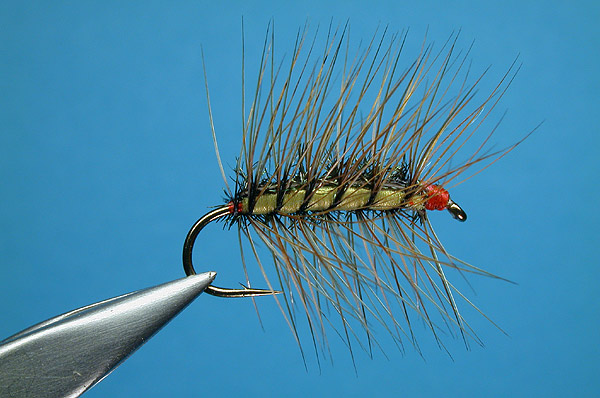
Maybe this will help: According to Woolly Wisdom written by Gary Soucie, it is called a Crackle-back Dry Woolly. Here is what Ed Story says: "I tie them with a special neck hackle with a thin stem and a more 'sparse' dry-fly hackle than is normally found. The reason for the sparse hackle is to allow the size, shape and color of the fly body to show through the hackle. I want just enough hackle to float the fly body. I use 4 1/2 evenly spaced hackle wraps on a size 12. A few years ago, we had Whiting Farms grow us 500 furnace 'saddles' with these features. The sold out in no time. The reason for the thin stem and sparse hackle is that I designed the pattern to float on top as a dry-fly terrestrial. No need to wait for a hatch."
Feather-Craft sells them in pale-yellow, brown-spider, lime and sulphur-orange versions. To fish the Crackleback as a dry fly, dress the hackle with floatant and fish it dead-drift or skitter it across the surface in the manner of an emerging caddis. Most anglers prefer to fish it both ways, as well as wet, on a single cast. As Ed Story explains, "Allow the fly to dead drift on top. If no hit on top after a few yards of drift, pull the fly under. Then 'skip' it with your rod tip as it goes downstream: a steady skip-skip-skip with your rod tip. To go really deep in off-color water, use a full-sinking line, a four-foot 4X or 5X tippet, and again skip-skip-skip the fly really deep for great success."
I use this fly and it is a go-to fly for me. It usually will always produce fish for me and when I tie it, I try to make sure to only put 4 1/2 evenly spaced hackle wraps. I use Punch Yarn for the body on most or will use floss. Make sure to put the skip-skip-skip into the retrieve because this is when this pattern is the most productive for me.
It is a great pattern for catching fish no matter what you want to call it.
Warren
Fly fishing and fly tying are two things that I do, and when I am doing them, they are the only 2 things I think about. They clear my mind.




 Reply With Quote
Reply With Quote

